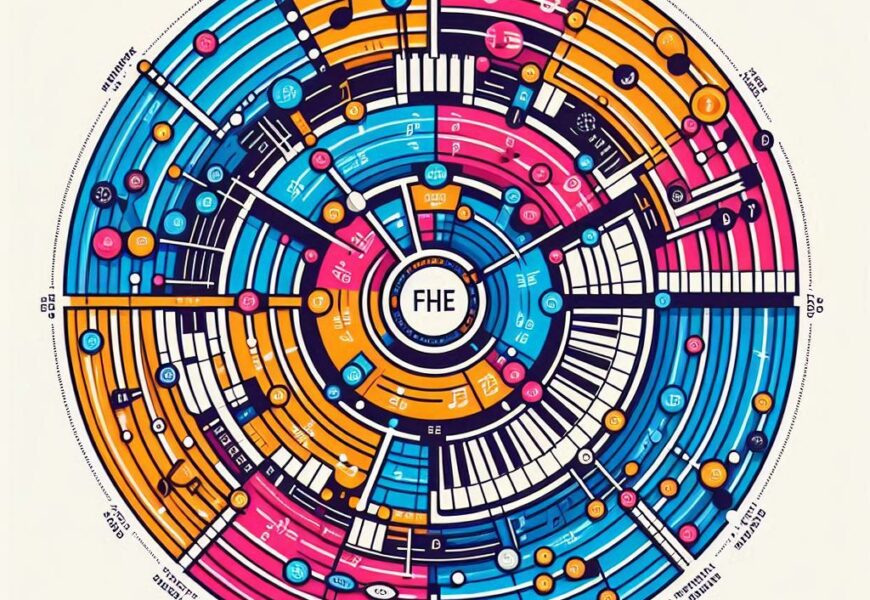Ever wondered why some ukulele melodies sound so put together while some sound out of place? It all comes down to the circle of fifths. Understanding how it works changed the way I play for the better, and that’s why I’ve decided to tell you all about it!
I’ll show you how it can help you use the chords properly and create a harmonious melody that sounds good to the ear, so start reading!
What Is the Circle of Fifths?
Starting from the top, the circle of fifths is a visual representation of relationships between the 12 tones on the chromatic scale. It starts from C and moves clockwise, with each step moving up by a perfect fifth: C, G, D, A, E, B, F#, Db, Ab, Eb, Bb, F, and back to C.
The clock-like drawing helps you understand the connections between the different keys and chords and learn which chords sound better together.
How to Use the Circle of Fifths While Playing the Ukulele
The circle of fifths can help you enhance your ukulele skills in many different ways. Here’s how you can use it.
Identifying Key Signatures
To identify the key signatures, imagine the circle of fifths as a clock, where each position represents a different key. Starting at C major (which you can find at the top of the circle), each step you take clockwise adds a sharp, while each counterclockwise step adds a flat.
For instance, G major is one clockwise step away from C and has one sharp (F#), while D major is two clockwise steps away from C and has two sharps (F# and C#)
Using the visual layout will help you remember and recognize the key signatures quickly.
Exploring Chord Progressions
Since the circle of fifths shows you which chords sound better when played together, you can use it to create more harmonious chord progressions.
Suppose you’re playing in C major. Looking at the circle, you’ll notice that the chords F and G are directly connected to C, which means they fit well together. Playing the chords in sequence, you’ll notice how playing F and G will naturally lead you to C and sound put together.
Transposing Melodies
One of my favorite uses of the circle of fifths is transposing songs. Instead of steering clear of songs played in keys that I’m not comfortable with, I use the circle to change the key. For instance, if you’re playing a song in C major but want to change it to G major, all you have to do is move five steps clockwise from C to G.
Why You Should Care About the Circle of Fifths
Some people see the circle of fifths as nothing more than a theory, but in my opinion, it’s a practical tool that you need to put to good use while playing.
Here are some reasons you should care about the circle of fifths:
- Quicker Song Learning: Understanding how the circle of fifths works can help you learn new songs faster and more intuitively, considering you’ll be able to anticipate progressions and chord changes easily.
- Better Improvisation: The circle of fifths shows you the relationship between different keys in music, giving you a chance to improvise new melodies while knowing which keys fit better together and which don’t.
- Easier Modulation: If you start to use the circle of fifths, you’ll find it easier to change keys and add dynamics while playing a song.
- Expanded Musical Knowledge: The circle of fifths is part of music theory, and learning how it works will expand your musical knowledge and help you better understand the keys, chords, and scales.
- Better Songwriting and Composing Skills: The circle gives you a framework that you can use as a reference while composing new songs, helping you discover and test different chord combinations.
Frequently Asked Questions
How does the circle of fifths relate to major and minor scales?
The circle shows the major keys and their relative minor keys. They’re paired together because they share the same key signatures. For instance, A minor is the relative minor of C major, which is shown in the circle.
Is the circle of fifths universal? Can I use it while playing different instruments?
Yes, the circle of fifths can be used for playing various instruments and genres. Its rules apply to all Western music, and it can help you understand the music theory, chord relationships, and key signatures, no matter what instrument you’re playing.
Wrapping Up
The circle of fifths is an invaluable tool for all ukulele players. If used correctly, it can help you identify key signatures, explore chord progressions, transpose melodies, and more. Not to mention, it makes it much easier to learn and compose new songs. After reaping its benefits myself, I highly encourage you to use it while practicing music.
